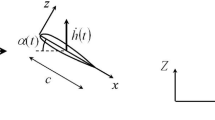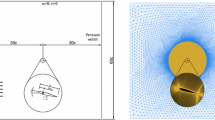Abstract
The interaction between two foils occurs in many aerodynamic or hydrodynamic applications. Although the characteristics of many airfoils are well documented, there is a limited amount of data for multiple airfoils in interaction and for large values of the angle of attack. This paper presents measurements of the turbulent flow around a two-airfoil T-tail type arrangement and the aerodynamic coefficients, for an incompressible flow at moderate Reynolds number. The study focuses mainly on large angles of attack, corresponding to detached flows on the airfoils, large wakes and involving vortex shedding. Phase averages of velocity fields are made building the flow time development relative to the vortex shedding. The understanding of the change in the tail lift coefficient versus angle of attack, between a two-airfoil arrangement and a single airfoil, is discussed in relation with the position and width of the wing wake and the pathlines of the shedding vortices.


















Similar content being viewed by others
References
Abbott IHA, Von Doenhoff AE (1949) Theory of wing sections, including a summary of airfoil data. Dover Publications, USA
Alam MM, Sakamoto H (2005) Investigation of Strouhal frequencies of two staggered bluff bodies and detection of multistable flow by wavelets. J Fluids Struct 20(3):425–449
Alam MM, Zhou Y, Yang HX, Guo H, Mi J (2010) The ultra-low Reynolds number airfoil wake. Exp Fluids 48(1):81–103
Anderson JM, Streitlien K, Barrett DS, Triantafyllou MS (1998) Oscillating foils of high propulsive efficiency. J Fluid Mech 360:41–72
Basley J, Pastur LR, Lusseyran F, Faure TM, Delprat N (2010) Experimental investigation of global modes in an incompressible cavity flow using time-resolved PIV. Exp Fluids 50(4):905–918
Bourgoyne DA, Hamel JM, Ceccio SL, Dowling DR (2003) Time-averaged flow over a hydrofoil at high Reynolds number. J Fluid Mech 496:365–404
Bourgoyne DA, Ceccio SL, Dowling DR (2005) Vortex shedding from a hydrofoil at high Reynolds number. J Fluid Mech 531:293–324
Cleaver DJ, Wang Z, Gursul I, Visbal M (2011) Lift enhancement by means of small-amplitude airfoil oscillations at low Reynolds numbers. AIAA J 49(9):2018–2033
Coronado Domenge PX, Ilie M (2012) Numerical study of helicopter blade-vortex mechanism of interaction using the potential flow theory. Appl Math Model 36:2841–2857
Critzos CC, Heyson HH, Boswinkle RW Jr (1955) Aerodynamic characteristics of NACA 0012 airfoil section at angles of attack from 0 degrees to 180 degrees. Tech. rep, NACA TN 3361
Devinant P, Laverne T, Hureau J (2002) Experimental study of wind-turbine airfoil aerodynamics in high turbulence. J Wind Eng Ind Aerodyn 90(6):689–707
Faure TM (2014) Velocity field and parametric analysis of a subsonic, medium-Reynolds number cavity flow. Exp Fluids 55:1822
Faure TM, Lusseyran F, Pastur L, Debesse P (2006) Développement d’instabilités dans un écoulement subsonique se développant au-dessus d’une cavité : mesures synchronisées PIV-LDV. In: 10e Congrès Francophone de Techniques Laser, Toulouse, France
Faure TM, Thach H, Basley J, Pastur L, Lusseyran F (2010) Moyenne de phase spatiale appliquée à des champs PIV résolus en temps. 12e Congrès Francophone de Techniques Laser. Nancy, France, pp 111–118
Favier D, Maresca C, Barbi C, Castex A (1987) Vortex influence on oscillating airfoils at high angle of attack. J Aircraft 24(7):424–432
Graftieaux L, Michard M, Grosjean N (2001) Combining PIV, POD and vortex identification algorithms for the study of unsteady turbulent swirling flows. Meas Sci Technol 12(9):1422
Hétru L (2015) Étude expérimentale et numérique de l’interaction aérodynamique entre deux profils : application au risque aéronautique du décrochage profond. PhD thesis, Université d’Aix-Marseille
Horner MB, Saliveros E, Galbraith R (1993) An examination of vortex convection effects during blade-vortex interaction. Zeitschrift fur Flugwissenschaften und Weltraumforschung 17(3):189–195
Hu J, Zhou Y (2008a) Flow structure behind two staggered circular cylinders. part 1. Downstream evolution and classification. J Fluid Mech 607:51–80
Hu J, Zhou Y (2008b) Flow structure behind two staggered circular cylinders. Part 2. Heat and momentum transport. J Fluid Mech 607:81–107
Huang RF, Lee HW (2000) Turbulence effect on frequency characteristics of unsteady motions in wake of wing. AIAA J 38(1):87–94
Huang RF, Lin CL (1995) Vortex shedding and shear-layer instability of wing at low-Reynolds numbers. AIAA J 33(8):1398–1403
Jones R, Cleaver D, Gursul I (2015) Aerodynamics of biplane and tandem wings at low Reynolds numbers. Exp Fluids 56:124
Katz J, Plotkin A (2001) Low-speed aerodynamics. Cambridge University Press, Cambridge
Khan F, Mueller T (1991) Tip vortex/airfoil interaction for a low Reynolds number canard/wing configuration. J Aircraft 28(3):181–186
Laitone EV (1997) Wind tunnel tests of wings at Reynolds numbers below 70 000. Exp Fluids 23(5):405–409
Lee T (2011) Flow past two in-tandem airfoils undergoing sinusoidal oscillations. Exp Fluids 51(6):1605–1621
Lee T, Su Y (2012) Low Reynolds number airfoil aerodynamic loads determination via line integral of velocity obtained with particle image velocimetry. Exp Fluids 53(5):1177–1190
Mueller TJ, DeLaurier JD (2003) Aerodynamics of small vehicles. Ann Rev Fluid Mech 35(1):89–111
Muijres FT, Johansson LC, Barfield R, Wolf M, Spedding GR, Hedenström A (2008) Leading-edge vortex improves lift in slow-flying bats. Science 319(5867):1250–1253
Panah AE, Buchholz JHJ (2014) Parameter dependence of vortex interactions on a two-dimensional plunging plate. Exp Fluids 55(3):1–19
Pastur L, Lusseyran F, Faure TM, Fraigneau Y, Pethieu R, Debesse P (2008) Quantifying the non-linear mode competition in the flow over an open cavity at medium Reynolds number. Exp Fluids 44(4):597–608
Prangemeier T, Rival D, Tropea C (2010) The manipulation of trailing-edge vortices for an airfoil in plunging motion. J Fluids Struct 26(2):193–204
Ramesh K, Gopalarathnam A, Granlund K, Ol MV, Edwards JR (2014) Discrete-vortex method with novel shedding criterion for unsteady aerofoil flows with intermittent leading-edge vortex shedding. J Fluid Mech 751:500–538
Ravi S, Watkins S, Watmuff J, Massey K, Petersen P, Marino M, Ravi A (2012) The flow over a thin airfoil subjected to elevated levels of freestream turbulence at low Reynolds numbers. Exp Fluids 53(3):637–653
Sarpkaya T (1975) An inviscid model of two-dimensional vortex shedding for transient and asymptotically steady separated flow over an inclined plate. J Fluid Mech 68(1):109–128
Scharpf DF, Mueller TJ (1992) Experimental study of a low Reynolds number tandem airfoil configuration. J Aircraft 29(2):231–236
Sicot C, Aubrun S, Loyer S, Devinant P (2006) Unsteady characteristics of the static stall of an airfoil subjected to freestream turbulence level up to 16%. Exp Fluids 41(4):641–648
Sumner D (2010) Two circular cylinders in cross-flow: a review. J Fluids Struct 26(6):849–899
Sumner D, Price S, Paidoussis M (2000) Flow-pattern identification for two staggered circular cylinders in cross-flow. J Fluid Mech 411:263–303
Sumner D, Richards M, Akosile O (2008) Strouhal number data for two staggered circular cylinders. J Wind Eng Ind Aerodyn 96(6):859–871
Sunada S, Yasuda T, Yasuda K, Kawachi K (2002) Comparison of wing characteristics at an ultralow Reynolds number. J Aircraft 39(2):331–338
Świrydczuk J (1990) A visualization study of the interaction of a free vortex with the wake behind an airfoil. Exp Fluids 9(4):181–190
Taylor RT, Ray EJ (1965) Deep-stall aerodynamic characteristics of T-tall aircraft. NASA Conf Aircraft Oper Prob SP-83:113–121
Von Kármán T (1911) Über den Mechanismus des Widerstandes, den ein bewegter Körper in einer Flüssigkeit erfährt. Nachrichten von der Gesellschaft der Wissenschaften zu Göttingen, Mathematisch-Physikalische Klasse, pp 509–517
Wang S, Zhou Y, Alam MM, Yang H (2014) Turbulent intensity and Reynolds number effects on an airfoil at low Reynolds numbers. Phys Fluids 26(11):115107
West GS, Apelt CJ (1982) The effects of tunnel blockage and aspect ratio on the mean flow past a circular cylinder with Reynolds numbers between \(10^4\) and \(10^5\). J Fluid Mech 114:361–377
Wu JZ, Lu XY, Denny AG, Fan M, Wu JM (1998) Post-stall flow control on an airfoil by local unsteady forcing. J Fluid Mech 371:21–58
Yarusevych S, Sullivan PE, Kawall JG (2009) On vortex shedding from an airfoil in low-Reynolds-number flows. J Fluid Mech 632:245–271
Zhou Y, Alam MM (2016) Wake of two interacting circular cylinders: a review. Int J Heat Fluid Flow 62:510–537
Author information
Authors and Affiliations
Corresponding author
Rights and permissions
About this article
Cite this article
Faure, T.M., Hétru, L. & Montagnier, O. Aerodynamic features of a two-airfoil arrangement. Exp Fluids 58, 146 (2017). https://doi.org/10.1007/s00348-017-2429-4
Received:
Revised:
Accepted:
Published:
DOI: https://doi.org/10.1007/s00348-017-2429-4




